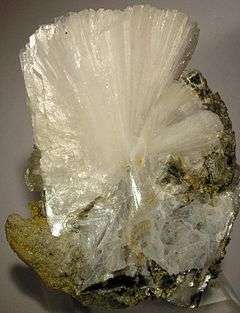Bertrandite
| Bertrandite | |
|---|---|
|
Bertrandite from the Golconda pegmatite, Minas Gerais, Brazil | |
| General | |
| Category | Sorosilicate |
| Formula (repeating unit) | Be4Si2O7(OH)2 |
| Strunz classification | 9.BD.05 |
| Crystal system | Orthorhombic |
| Crystal class |
Pyramidal (mm2) H-M symbol: (mm2) |
| Space group | Ccm21 |
| Unit cell |
a = 8.7135(4) Å, b = 15.268(1) Å, c = 4.5683(3) Å; Z = 4 |
| Identification | |
| Color | Colorless to pale yellow |
| Crystal habit | Thin tabular, prismatic to needle-like crystals commonly in radial clusters |
| Twinning | Common on {011} or {021} forming heart or V shaped twins |
| Cleavage | Perfect on {001}; distinct on {100}, {010} and {110} |
| Mohs scale hardness | 6 - 7 |
| Luster | Vitreous, pearly on cleavage surfaces |
| Diaphaneity | Transparent |
| Specific gravity | 2.59 - 2.60 |
| Optical properties | Biaxial (-) |
| Refractive index | nα = 1.591 nβ = 1.605 nγ = 1.614 |
| Birefringence | δ = 0.023 |
| 2V angle | Measured: 73° to 81° |
| References | [1][2][3] |
Bertrandite is a beryllium sorosilicate hydroxide mineral with composition: Be4Si2O7(OH)2. Bertrandite is a colorless to pale yellow orthorhombic mineral with a hardness of 6-7.
It is commonly found in beryllium rich pegmatites and is in part an alteration of beryl. Bertrandite often occurs as a pseudomorphic replacement of beryl. Associated minerals include beryl, phenakite, herderite, tourmaline, muscovite, fluorite and quartz.[1]
It, with beryl, are ores of beryllium.
It was discovered near Nantes, France in 1883 and named after French mineralogist, Emile Bertrand (1844–1909).[1][2][3]
See also
References
| Wikimedia Commons has media related to Bertrandite. |
This article is issued from Wikipedia - version of the 11/23/2016. The text is available under the Creative Commons Attribution/Share Alike but additional terms may apply for the media files.
